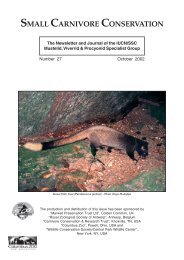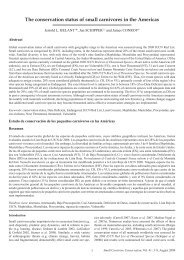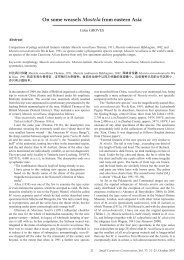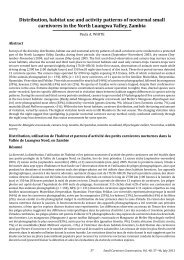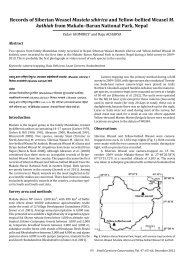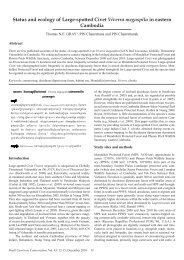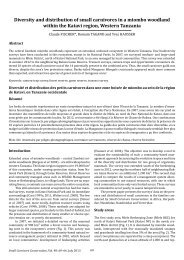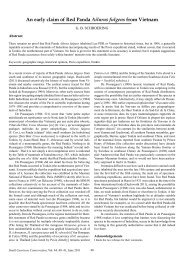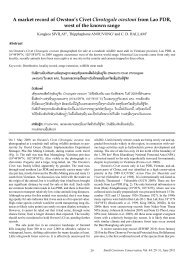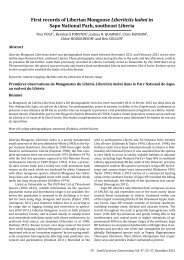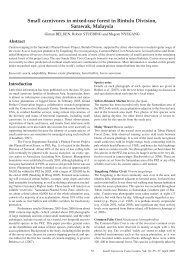The 2008 IUCN red listings of the world's small carnivores
The 2008 IUCN red listings of the world's small carnivores
The 2008 IUCN red listings of the world's small carnivores
Create successful ePaper yourself
Turn your PDF publications into a flip-book with our unique Google optimized e-Paper software.
<strong>The</strong> <strong>2008</strong> <strong>IUCN</strong> <strong>red</strong> <strong>listings</strong> <strong>of</strong> <strong>the</strong> world’s <strong>small</strong> <strong>carnivores</strong>Jan SCHIPPER¹*, Michael HOFFMANN¹, J. W. DUCKWORTH² and James CONROY³Abstract<strong>The</strong> global conservation status <strong>of</strong> all <strong>the</strong> world’s mammals was assessed for <strong>the</strong> <strong>2008</strong> <strong>IUCN</strong> Red List. Of <strong>the</strong> 165 species <strong>of</strong> <strong>small</strong> <strong>carnivores</strong>recognised during <strong>the</strong> process, two are Extinct (EX), one is Critically Endange<strong>red</strong> (CR), ten are Endange<strong>red</strong> (EN), 22 Vulnerable(VU), ten Near Threatened (NT), 15 Data Deficient (DD) and 105 Least Concern. Thus, 22% <strong>of</strong> <strong>the</strong> species for which a category wasassigned o<strong>the</strong>r than DD were assessed as threatened (i.e. CR, EN or VU), as against 25% for mammals as a whole. Among otters, seven(58%) <strong>of</strong> <strong>the</strong> 12 species for which a category was assigned were identified as threatened. This reflects <strong>the</strong>ir attachment to rivers ando<strong>the</strong>r waterbodies, and heavy trade-driven hunting. <strong>The</strong> <strong>IUCN</strong> Red List species accounts are living documents to be updated annually,and fur<strong>the</strong>r information to refine <strong>listings</strong> is welcome.Keywords: conservation status, Critically Endange<strong>red</strong>, Data Deficient, Endange<strong>red</strong>, Extinct, global threat listing, Least Concern, NearThreatened, VulnerableIntroduction<strong>The</strong> <strong>IUCN</strong> Red List <strong>of</strong> Threatened Species is <strong>the</strong> most authoritativeresource currently available on <strong>the</strong> conservation status <strong>of</strong> <strong>the</strong>world’s biodiversity. In recent years, <strong>the</strong> overall number <strong>of</strong> speciesincluded on <strong>the</strong> <strong>IUCN</strong> Red List has grown rapidly, largely asa result <strong>of</strong> ongoing global assessment initiatives that have helpedexpand its coverage both geographically and taxonomically (Rodrigueset al. 2006). <strong>The</strong> <strong>2008</strong> <strong>IUCN</strong> Red List <strong>of</strong> Threatened Speciesholds species-based information on more than 45,000 individualspecies, including assessments for many never before assessed,such as all reef-building corals. <strong>The</strong> <strong>2008</strong> <strong>IUCN</strong> Red List also providesa complete reassessment <strong>of</strong> <strong>the</strong> Class Mammalia, marking<strong>the</strong> first time that all mammals have been globally assessed since1996 (see <strong>IUCN</strong> 1996). Such reassessments are vital because<strong>IUCN</strong> Red List assessments lapse after 10 years – indeed some3,300 mammal species assessments have been flagged as ‘out-<strong>of</strong>date’since 2006 – and because re-evaluation permits determination<strong>of</strong> <strong>the</strong> changing status <strong>of</strong> biodiversity over time (Butchart etal. 2006).In contrast to <strong>the</strong> 1996 assessment for mammals, a significantadvance for <strong>2008</strong> is <strong>the</strong> move towards ‘comprehensive’ assessments,in which each species-level assessment is underpinnedby a detailed set <strong>of</strong> peer-reviewed supporting documentation. Textualinformation was collected about <strong>the</strong> distribution, population,habitat and ecology, threats, and conservation measures for eachspecies. In addition a digital map <strong>of</strong> current known limits <strong>of</strong> distributionwas created for each species in a Geographic InformationSystem. General information was derived from <strong>the</strong> literature, refinedat workshops and via correspondence by expert knowledge,and later cross-checked for consistency. <strong>The</strong> result is a documentedand peer-reviewed assessment for all mammals <strong>of</strong> <strong>the</strong> world.<strong>The</strong> current paper reports briefly on <strong>the</strong> results <strong>of</strong> <strong>the</strong> <strong>2008</strong><strong>IUCN</strong> Red List for <strong>small</strong> <strong>carnivores</strong>. <strong>The</strong> term ‘<strong>small</strong> carnivore’ isused herein to define <strong>the</strong> subset <strong>of</strong> <strong>the</strong> Order Carnivora that fallsunder <strong>the</strong> remits <strong>of</strong> <strong>the</strong> <strong>IUCN</strong>/SSC Small Carnivore SpecialistGroup (SCSG) and <strong>the</strong> <strong>IUCN</strong>/SSC Otter Specialist Group (OSG).Family-level taxonomy within <strong>the</strong>se groups has been relativelyunstable, and <strong>the</strong> analysis used <strong>the</strong> following families: Ailuridae(Red Panda Ailurus fulgens; one species), Eupleridae (endemic toMadagascar; nine species), Herpestidae (mongooses; 34), Mephiti-dae (skunks and stink-badgers; 12), Mustelidae (weasels, martens,otters, badgers and allies; 59), Nandiniidae (African Palm-civetNandinia binotata; one), Prionodontidae ([Asian] linsangs; two),Procyonidae (raccoons, coatis and allies; 14), and Viverridae (civets,including oyans [= ‘African linsangs’]; 33). <strong>The</strong> data reportedon herein are freely and publicly available via <strong>the</strong> <strong>2008</strong> <strong>IUCN</strong> RedList website (www.iucn<strong>red</strong>list.org/mammals).<strong>The</strong> processes and <strong>the</strong> methodologies used in <strong>the</strong> assessment<strong>of</strong> <strong>the</strong> world’s mammals are detailed elsewhere (Schipper et al.<strong>2008</strong>). Specifically, as concerns <strong>small</strong> <strong>carnivores</strong>, <strong>the</strong> nine species<strong>of</strong> Malagasy <strong>carnivores</strong> (Eupleridae) were reviewed at a workshopheld in Antananarivo, Madagascar, in April 2005, as part <strong>of</strong> alarger workshop to assess <strong>the</strong> status <strong>of</strong> <strong>the</strong> island’s entire mammalfauna. European and Asian <strong>small</strong> <strong>carnivores</strong> were assessed at aworkshop held in Cuc Phuong National Park, Vietnam, over 3–7July 2006, where all species were evaluated by more than 20 participants.Although <strong>the</strong> status <strong>of</strong> <strong>the</strong> mainland African species wasalso conside<strong>red</strong> during this workshop, <strong>the</strong> latter were subjected to aprocess <strong>of</strong> additional expert consultation between 2006 and <strong>2008</strong>,with documentation compiled in partnership with <strong>the</strong> forthcomingMammals <strong>of</strong> Africa (Kingdon & H<strong>of</strong>fmann in press). Additionalinformation on <strong>the</strong> <strong>small</strong> <strong>carnivores</strong> <strong>of</strong> Europe and <strong>the</strong> Mediterraneancountries was collected through initiatives to undertake regional<strong>IUCN</strong> Red Lists for mammals <strong>of</strong> <strong>the</strong>se two regions. Finally,New World species were evaluated via expert consultation during2006–<strong>2008</strong>, and a mini-workshop held in Zamorano, Honduras,on 30 January <strong>2008</strong>, to review <strong>the</strong> assessment results.Threat status <strong>of</strong> <strong>small</strong> <strong>carnivores</strong>Presented here is a brief synopsis <strong>of</strong> <strong>the</strong> results <strong>of</strong> <strong>the</strong> <strong>2008</strong> <strong>IUCN</strong>Red List for <strong>small</strong> <strong>carnivores</strong>; a more detailed analysis and discussion<strong>of</strong> <strong>the</strong> findings and <strong>the</strong>ir implications for conserving <strong>small</strong><strong>carnivores</strong> is in preparation and will appear elsewhere. Small<strong>carnivores</strong> are ecologically diverse, including species that spendtime on land, in freshwater and/or in <strong>the</strong> sea; ranging from entirelyarboreal to entirely ground-dwelling; and occupying a range <strong>of</strong>habitats from desert to moist tropical forests to taiga, and frombelow sea level to more than 4,000 m asl.As with mammals in general, <strong>small</strong> <strong>carnivores</strong> are not equallydistributed around <strong>the</strong> world, being more concentrated in tropi-29 Small Carnivore Conservation, Vol. 39: 29–34, October <strong>2008</strong>
Schipper et al.cal areas. <strong>The</strong> greatest number <strong>of</strong> species occur in <strong>the</strong> Afrotropicalrealm (57 species/30%): 48 occur on <strong>the</strong> mainland, and nine liveonly in Madagascar. <strong>The</strong> second highest richness is <strong>the</strong> Indomalayanrealm (47 species/26%), followed by <strong>the</strong> Neotropical realm(33 species/18%), <strong>the</strong> Palaearctic realm (16 species/16%) and <strong>the</strong>Nearctic realm (18 species/10%). Percentages exceed 100% becausea number <strong>of</strong> species inhabit more than one realm. No native<strong>small</strong> <strong>carnivores</strong> are known from <strong>the</strong> Antarctic, Australasian orOceanic realms.Of <strong>the</strong> 165 species assessed (Appendix 1), two (Sea MinkNeovison macrodon and Giant Fossa Cryptoprocta spelea) areextinct (EX), one (Malabar Civet Viverra civettina) is CriticallyEndange<strong>red</strong> (CR), ten are Endange<strong>red</strong> (EN), 22 Vulnerable (VU),ten Near Threatened (NT), 15 Data Deficient (DD), and 105 LeastConcern (Figure 1). <strong>The</strong>refore, some 22% <strong>of</strong> <strong>the</strong> <strong>small</strong> <strong>carnivores</strong>for which sufficient information was available to make a reliableassessment <strong>of</strong> extinction risk were categorised as threatened (CR,EN and VU). However, given that around 9% <strong>of</strong> <strong>small</strong> <strong>carnivores</strong>are listed as Data Deficient, <strong>the</strong> actual percentage <strong>of</strong> species thatare threatened could lie anywhere between 20% and 30% (if, respectively,none or all DD species are in fact threatened).In general, populations <strong>of</strong> <strong>small</strong> <strong>carnivores</strong> were assessedas decreasing (40%) or unknown (35%), with fewer being stable(22%) and only 2% (three species) increasing.Threats and criteria for listingFigure 1. Summary <strong>of</strong> <strong>IUCN</strong> Red List results for <strong>small</strong> <strong>carnivores</strong>,by categories. Letters refer to categories and number to <strong>the</strong>number <strong>of</strong> species in each category.Although some species <strong>of</strong> <strong>small</strong> carnivore thrive in humandominatedlandscapes (such as Nor<strong>the</strong>rn Raccoon Procyon lotorand Hooded Skunk Mephitis macroura), most do not. <strong>The</strong>y areincreasingly impacted by habitat conversion, overexploitation(hunting; intentionally or as by-catch), contamination (especiallyin freshwater), and disease.<strong>The</strong> <strong>IUCN</strong> Red List Categories and Criteria (2001) facilitates<strong>the</strong> evaluation <strong>of</strong> each species against quantitative thresholds forpopulation decline, geographic range size, <strong>small</strong> populations anddecline and very <strong>small</strong> or restricted populations. This makes it possibleto compare species using <strong>the</strong> same standards and methods.However, <strong>the</strong> precision and accuracy <strong>of</strong> <strong>the</strong> species assessment is<strong>of</strong>ten driven by <strong>the</strong> state <strong>of</strong> knowledge for <strong>the</strong> species: <strong>the</strong> morethat is known, <strong>the</strong> better <strong>the</strong> criteria can be applied. <strong>The</strong>refore,<strong>the</strong> species accounts in <strong>the</strong> <strong>2008</strong> <strong>IUCN</strong> Red List are ‘living documents’and fur<strong>the</strong>r information on all species is welcomed. Fulldocumentation for <strong>the</strong> categories and criteria used are available athttp://www.iucn<strong>red</strong>list.org/info/categories_criteria2001.Of <strong>the</strong> 33 species identified as threatened (CR, EN and VU),23 (69%) are listed using <strong>the</strong> A Criterion (population decline),seven (20%) using <strong>the</strong> B Criterion (geographic range size), three(8%) using <strong>the</strong> C Criterion (population size and decline; one <strong>of</strong>which is also listed under B), one (3%) using <strong>the</strong> D Criterion (very<strong>small</strong> or restricted population), and none using <strong>the</strong> E Criterion(quantitative analysis).Of <strong>the</strong> 23 species identified as threatened based on populationdecline, only one listed <strong>the</strong> decline as reversible and havingceased: Sea Otter Enhydra lutris. Nineteen species were listed usingdata from <strong>the</strong> past (over a three-generation time-span definedper species) and six species were listed using projected future declines(three used both past and future). Of all <strong>the</strong>se 23 species,95% are declining because <strong>of</strong> a <strong>red</strong>uction in area <strong>of</strong> occupancy(AOO), extent <strong>of</strong> occurrence (EOO) and/or habitat quality, while60% are assessed as declining from actual or potential levels <strong>of</strong>exploitation.<strong>The</strong> future <strong>of</strong> <strong>small</strong> <strong>carnivores</strong>Some <strong>small</strong> carnivore species have proven resilient and adaptableto various threats. Some have recolonised areas from which <strong>the</strong>ywere extinguished or have recove<strong>red</strong> from low populations whenthreats were <strong>red</strong>uced. Thus, if threats can be <strong>red</strong>uced significantly,many species currently threatened are likely to recover. An exampleis Black-footed Ferret Mustela nigripes, formerly Extinct in<strong>the</strong> Wild (EW) which is now, following a massive conservationeffort to reintroduce populations in its native range, categorised asEndange<strong>red</strong> (EN).Small <strong>carnivores</strong> may be faring slightly better than mammalsoverall: 22% <strong>of</strong> <strong>the</strong> <strong>small</strong> carnivore species for which a categorywas assigned o<strong>the</strong>r than DD were assessed as threatened (CR, ENand VU), compa<strong>red</strong> with 25% for all mammals. Overexploitationcan be devastating, as was <strong>the</strong> case with <strong>the</strong> now extinct Sea Mink.As suitable habitats decline (most notably in Sou<strong>the</strong>ast Asia), exploitationmay result in additional localised extirpations leading,in aggregate, to losses <strong>of</strong> species.Emerging threats that could affect <strong>small</strong> <strong>carnivores</strong> includecontagious disease and climate change. Among <strong>the</strong> most susceptibleto numerous threats are <strong>the</strong> aquatic and semi-aquatic species,partially due to <strong>the</strong>ir restricted, <strong>of</strong>ten linear, distribution along riversand water bodies (where humans also frequent) and becausefreshwater systems <strong>the</strong>mselves are threatened by contamination,eutrophication, overexploitation (<strong>of</strong> prey and even water itself)and, increasingly, water shortage and/or flooding. Among <strong>small</strong><strong>carnivores</strong>, otters are most threatened, with seven (58%) <strong>of</strong> <strong>the</strong> 12species for which a category was assigned identified as threatened(CR, EN and VU).AcknowledgementsAssessing <strong>the</strong> conservation status <strong>of</strong> all <strong>the</strong> world’s mammals was an enormousundertaking as shown by <strong>the</strong> list <strong>of</strong> acknowledgements in SchipperSmall Carnivore Conservation, Vol. 39, October <strong>2008</strong>30
Small <strong>carnivores</strong> <strong>2008</strong> <strong>IUCN</strong> <strong>red</strong> <strong>listings</strong>et al. (<strong>2008</strong>); we repeat our thanks to all <strong>the</strong>se bodies and individuals here.Specifically for <strong>the</strong> <strong>small</strong> <strong>carnivores</strong>, most <strong>of</strong> all we thank <strong>the</strong> many workshopparticipants and correspondents who assessed <strong>the</strong>se species. <strong>The</strong>Old World <strong>small</strong> carnivore workshop was hosted by <strong>IUCN</strong> in collaborationwith <strong>the</strong> <strong>IUCN</strong>/SSC Small Carnivore Specialist Group, <strong>the</strong> Carnivore& Pangolin Conservation Program, and <strong>the</strong> Institute <strong>of</strong> Applied Ecology,Rome. Particular thanks are due Scott Roberton and Tran Quang Phuongfor <strong>the</strong>ir help with <strong>the</strong> local logistics; Wes Sechrest, Mike H<strong>of</strong>fmann, JanSchipper, Noura Bakkour, Beth Polidoro, Hank Shugart, Monica Rulliand Gianluca Catulo facilitated. Participants at this meeting included:Alexei Abramov, Amy Dunham, Annette Olsson, Anwaruddin Choudury,Mohd Azlan J., Barney Long, Belden Giman, Budsabong Kanchanasaka,<strong>the</strong> late Chris Wozencraft, Nguyen Xuan Dang, Divya Muddapa, JasonHon, Michael Lau, Philippe Gaubert, Pralad Yonzon, Rob Timmins, ScottRoberton, Than Zaw, Wang Ying-xiang and Will Duckworth. Madagascarmammals, including <strong>the</strong> <strong>small</strong> <strong>carnivores</strong>, were assessed with supportfrom <strong>the</strong> CI-Madagascar Center for Biodiversity Conservation, and weare grateful to Leon Rajaobelina and Frank Hawkins for facilitating thissupport and to Harison Randrianasolo for helping with logistics. FrankHawkins, Joanna Durbin, and Luke Dollar, among o<strong>the</strong>rs, provided usefulinput, and Frank Hawkins kindly reviewed <strong>the</strong> final assessments andsupporting documentation. An impromptu evaluation <strong>of</strong> <strong>the</strong> proposed assessments<strong>of</strong> New World <strong>small</strong> <strong>carnivores</strong> was made during an <strong>IUCN</strong> RedList workshop in Honduras, and we would like to especially thank thosewho contributed: Alf<strong>red</strong>o Cuaron, Louise Emmons, Jose Gonzalez-Maya,Kris Helgen, Tim McCarthy, Fiona Reid, Ramael Samudio and RobertTimm.ReferencesButchart, S. H. M., Akcakaya, H. R., Kennedy, E. & Hilton-Taylor, C.2006. Biodiversity indicators based on trends in conservation status:strengths <strong>of</strong> <strong>the</strong> <strong>IUCN</strong> Red List Index. Conservation Biology 20:579–581.<strong>IUCN</strong> 1996. 1996 <strong>IUCN</strong> Red List <strong>of</strong> threatened animals. <strong>IUCN</strong>, Gland,Switzerland.<strong>IUCN</strong> 2001. <strong>IUCN</strong> Red List categories and criteria: version 3.1. <strong>IUCN</strong>,Gland, Switzerland, and Cambridge.Kingdon, J. S. & H<strong>of</strong>fmann, M. (eds) In press. <strong>The</strong> mammals <strong>of</strong> Africa,vol. 5. Carnivores, pangolins, rhinos, and equids. AcademicPress, Amsterdam.Rodrigues A. S. L., Pilgrim, J. D., Lamoreux, J. F., H<strong>of</strong>fmann, M. &Brooks, T. M. 2006. <strong>The</strong> value <strong>of</strong> <strong>the</strong> <strong>IUCN</strong> Red List for conservation.Trends in Ecology and Evolution 21: 71–76.Schipper, J. et al. [132 authors] <strong>2008</strong>. <strong>The</strong> status <strong>of</strong> <strong>the</strong> world’s land andmarine mammals: diversity, threat and knowledge. Science 322:225-230.Wozencraft, W. C. 2005. Order Carnivora. Pp. 532–628 in Wilson, D. E.& Reeder, D. M. (eds) Mammalian species <strong>of</strong> <strong>the</strong> world, 3rd edition.Johns Hopkins University Press, Baltimore, USA.¹<strong>IUCN</strong> Species Programme, <strong>IUCN</strong>, 28 Rue Mauverney, 1196Gland, Switzerland and <strong>IUCN</strong>/SSC-CI/CABS BiodiversityAssessment Unit, c/o Center for Applied Biodiversity Science,Conservation International, 2011 Crystal Drive, Arlington,VA 22202, USA.²<strong>IUCN</strong>/SSC Small Carnivore Red List Authority; currentaddress PO Box 5573, Vientiane, Lao PDR³Celtic Environment Ltd, 10 Old Mart Road, Torphins,Banchory, Kincardineshire, AB31 4JG, UK.*Corresponding author email: j.schipper@conservation.orgAppendix 1. <strong>The</strong> <strong>2008</strong> <strong>IUCN</strong> Red List for <strong>small</strong> <strong>carnivores</strong>.Taxon¹ English Name Category CriteriaFamily AILURIDAEAilurus fulgens Red Panda VU C1Family EUPLERIDAECryptoprocta ferox Fossa VU A2cdCryptoprocta spelea Giant Fossa EXEupleres goudotii Falanouc NT A2cdFossa fossana Fanaloka NT A2cdGalidia elegans Malagasy Ring-tailed Mongoose LCGalidictis fasciata Broad-striped Mongoose NTGalidictis grandidieri Giant-striped Mongoose EN B1ab(i,ii,iii,v); C2a(ii)Mungotictis decemlineata Malagasy Narrow-striped Mongoose VU B1ab(ii,iii,v)Salanoia concolor Brown-tailed Mongoose VU B1ab(ii,iii)Family HERPESTIDAEAtilax paludinosus Marsh Mongoose LCBdeogale crassicauda Bushy-tailed Mongoose LCBdeogale jacksoni Jackson’s Mongoose NT A2cdBdeogale nigripes Black-footed Mongoose LCBdeogale omnivora² Sokoke Bushy-tailed Mongoose VU A2cCrossarchus alexandri Alexander’s Cusimanse LCCrossarchus ansorgei Ansorge’s Cusimanse DDCrossarchus obscurus Common Cusimanse LCCrossarchus platycephalus Cameroon Cusimanse LCCynictis penicillata Yellow Mongoose LC31 Small Carnivore Conservation, Vol. 39, October <strong>2008</strong>
Schipper et al.Taxon¹ English Name Category CriteriaDologale dybowskii Pousargues’s Mongoose DDHelogale hirtula Somali Dwarf Mongoose LCHelogale parvula Common Dwarf Mongoose LCHerpestes brachyurus Short-tailed Mongoose LCHerpestes edwardsii Indian Grey Mongoose LCHerpestes² flavescens Kaokoveld Slender Mongoose LCHerpestes fuscus Brown Mongoose VU A2cHerpestes ichneumon Egyptian Mongoose LCHerpestes javanicus Small Asian Mongoose LCHerpestes naso Long-nosed Mongoose LCHerpestes² ochraceus Somali Slender Mongoose LCHerpestes² pulverulentus Cape Grey Mongoose LCHerpestes² sanguineus Slender Mongoose LCHerpestes semitorquatus Colla<strong>red</strong> Mongoose DDHerpestes smithii Ruddy Mongoose LCHerpestes urva Crab-eating Mongoose LCHerpestes vitticollis Stripe-necked Mongoose LCIchneumia albicauda White-tailed Mongoose LCLiberiictis kuhni Liberian Mongoose VU A2cdMungos gambianus Gambian Mongoose LCMungos mungo Banded Mongoose LCParacynictis selousi Selous’s Mongoose LCRhynchogale melleri Meller’s Mongoose LCSuricata suricatta Meerkat LCFamily MEPHITIDAEConepatus chinga Molina’s Hog-nosed Skunk LCConepatus humboldtii Humboldt’s Hog-nosed Skunk LCConepatus leuconotus American Hog-nosed Skunk LCConepatus semistriatus Striped Hog-nosed Skunk LCMephitis macroura Hooded Skunk LCMephitis mephitis Striped Skunk LCMydaus javanensis Sunda Stink-badger LCMydaus marchei Palawan Stink-badger LCSpilogale angustifrons Sou<strong>the</strong>rn Spotted Skunk LCSpilogale gracilis Western Spotted Skunk LCSpilogale putorius Eastern Spotted Skunk LCSpilogale pygmaea Pygmy Spotted Skunk VU A2cFamily MUSTELIDAEAonyx capensis African Clawless Otter LCAonyx cinereus³ Asian Small-clawed Otter VU A2acdAonyx congicus² Congo Clawless Otter LCArctonyx collaris Hog Badger NTEira barbara Tayra LCEnhydra lutris Sea Otter EN A1aGalictis cuja Lesser Grison LCGalictis vittata Greater Grison LCGulo gulo Wolverine NTIctonyx libycus³ Libyan Striped Weasel LCIctonyx striatus Zorilla LCLontra canadensis North American Otter LCLontra felina Marine Otter EN A3cdLontra longicaudis Neotropical Otter DDLontra provocax Sou<strong>the</strong>rn River Otter EN A3cdLutra lutra² Eurasian Otter NTLutra maculicollis Spotted-necked Otter LCLutra sumatrana Hairy-nosed Otter EN A2cdSmall Carnivore Conservation, Vol. 39, October <strong>2008</strong>32
Small <strong>carnivores</strong> <strong>2008</strong> <strong>IUCN</strong> <strong>red</strong> <strong>listings</strong>Taxon¹ English Name Category CriteriaLutrogale perspicillata Smooth-coated Otter VU A2acdLyncodon patagonicus Patagonian Weasel DDMartes americana American Marten LCMartes flavigula Yellow-throated Marten LCMartes foina Stone Marten LCMartes gwatkinsii Nilgiri Marten VU B1ab(iii,iv)Martes martes European Pine Marten LCMartes melampus Japanese Marten LCMartes pennanti Fisher LCMartes zibellina Sable LCMeles anakuma Japanese Badger LCMeles leucurus Asian Badger LCMeles meles Eurasian Badger LCMellivora capensis Honey Badger LCMelogale everetti Bornean Ferret Badger DDMelogale moschata Small-too<strong>the</strong>d Ferret Badger LCMelogale orientalis Javan Ferret Badger DDMelogale personata Large-too<strong>the</strong>d Ferret Badger DDMustela africana Amazon Weasel LCMustela altaica Altai Weasel NTMustela erminea Ermine LCMustela eversmanii Steppe Polecat LCMustela felipei Colombian Weasel VU B1ab(ii,iii)Mustela frenata Long-tailed Weasel LCMustela itatsi Japanese Weasel LCMustela kathiah Yellow-bellied Weasel LCMustela lutreola European Mink EN A2ceMustela lutreolina Indonesian Mountain Weasel DDMustela nigripes Black-footed Ferret EN D1Mustela nivalis Least Weasel LCMustela nudipes Malay Weasel LCMustela putorius European Polecat LCMustela sibirica Siberian Weasel LCMustela strigidorsa Stripe-backed Weasel LCMustela subpalmata Egyptian Weasel LCNeovison macrodon Sea Mink EXNeovison vison American Mink LCPoecilogale albinucha African Striped Weasel LCPteronura brasiliensis Giant Otter EN A3cdTaxidea taxus American Badger LCVormela peregusna Marbled Polecat VU A2cFamily NANDINIIDAENandinia binotata African Palm-civet LCFamily PRIONODONTIDAEPrionodon linsang Banded Linsang LCPrionodon pardicolor Spotted Linsang LCFamily PROCYONIDAEBassaricyon alleni Allen’s Olingo LCBassaricyon beddardi Beddard’s Olingo LCBassaricyon gabbii Gabbi’s Olingo LCBassaricyon lasius Harris’s Olingo DDBassaricyon pauli Chirique Olingo DDBassariscus astutus Ringtail LCBassariscus sumichrasti Cacomistle LCNasua narica White-nosed Coati LCNasua nasua South American Coati LC33 Small Carnivore Conservation, Vol. 39, October <strong>2008</strong>
Schipper et al.Taxon¹ English Name Category CriteriaNasuella olivacea Mountain Coati DDPotos flavus Kinkajou LCProcyon cancrivorus Crab-eating Raccoon LCProcyon lotor Nor<strong>the</strong>rn Raccoon LCProcyon pygmaeus Cozumel Raccoon EN B1ab(ii,iii) + 2ab(ii,iii)Family VIVERRIDAEArctictis binturong Binturong VU A2cdArctogalidia trivirgata Small-too<strong>the</strong>d Palm Civet LCChrotogale owstoni Owston’s Civet VU A2cdCivettictis civetta African Civet LCCynogale bennettii Otter Civet EN A2ceDiplogale hosei Hose’s Civet VU A2c+3cGenetta abyssinica Ethiopian Genet LCGenetta angolensis Miombo Genet LCGenetta bourloni Bourlon’s Genet NT A2cdGenetta cristata Crested Genet VU A2cdGenetta genetta Common Genet LCGenetta johnstoni Johnston’s Genet VU A2cdGenetta maculata Central African Large-spotted Genet LCGenetta pardina West African Large-spotted Genet LCGenetta piscivora Aquatic Genet DDGenetta poensis King Genet DDGenetta servalina Servaline Genet LCGenetta thierryi Hausa Genet LCGenetta tigrina South African Large-spotted Genet LCGenetta victoriae Giant Genet LCHemigalus derbyanus Banded Civet VU A2cd+3cMacrogalidia musschenbroekii Sulawesi Palm Civet VU A2cPaguma larvata Masked Palm Civet LCParadoxurus hermaphroditus Common Palm Civet LCParadoxurus jerdoni Brown Palm Civet LCParadoxurus zeylonensis Golden Palm Civet VU B1ab(i,iii,v)Poiana leightoni Leighton’s Linsang DDPoiana richardsonii African Linsang LCViverra civettina Malabar Civet CR C2a(i)Viverra megaspila Large-spotted Civet VU A2cd+3cdViverra tangalunga Malay Civet LCViverra zibetha Large Indian Civet NTViverricula indica Small Indian Civet LC¹Genus and species limits and spellings mostly follow Wozencraft (2005), selected to be a readily available, widely used, source.²Divergences from Wozencraft (2005), to align <strong>the</strong> present list’s limits with those <strong>of</strong> Kingdon & H<strong>of</strong>fmann (in press), and to consider Lutra nipponconspecific with L. lutra.³Divergences from Wozencraft (2005), reflecting that Aonyx and Ictonyx are masculine genera and <strong>the</strong>se species’ names are thus correctly A. cinereusand I. libycus, not A. cinerea and I. libyca.Small Carnivore Conservation, Vol. 39, October <strong>2008</strong>34



